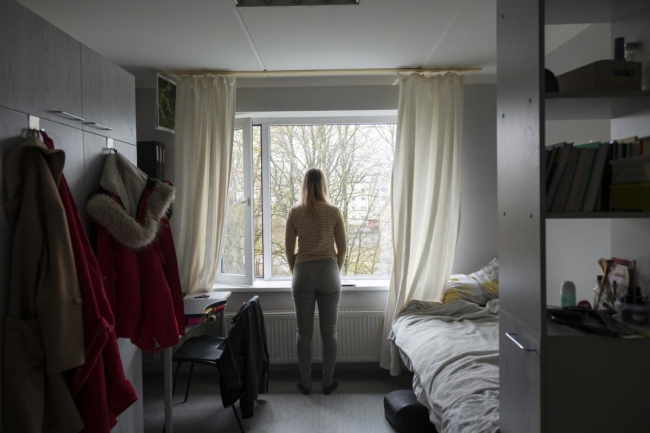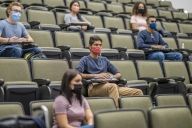You have /5 articles left.
Sign up for a free account or log in.

Joel Carillet/iStock
Since the first days students returned to campuses in August, they’ve been getting in trouble. The University of Connecticut, days into the semester, sent several students home for partying during a mandatory quarantine. Over the course of the fall term, Ohio State University handed out more than 1,500 suspensions to students for breaking COVID-19 guidelines.
It would seem easy to say that students don’t care about COVID-19 when they’re holding pool parties and rush events. But recent data suggest that, on the whole, students are worried.
In a recent survey of over 1,000 college students nationwide, conducted by the think tanks Third Way and New America, COVID-19 ranked as a top concern. More students said they were concerned about catching and spreading COVID-19 than said they were concerned about their own mental health, paying bills or getting a job after graduation.
“College students in particular have gotten a really bad rap for potentially not caring about coronavirus or social distancing or some of these guidelines,” said Tamara Hiler, director of education at Third Way. “It’s clear from our data that that’s not the case. Students are worried about their own safety and their own health, particularly the health of their families.”
All in all, 82 percent of students in the study said they were worried about catching COVID-19 and spreading it to others. About 86 percent said they were afraid of friends and family catching the disease. Both those numbers went up for Black students, Latinx students and students who were caring for a child or relative.
Of course there are the partiers, the rule breakers, the blasé. But in interviews students say that college campuses, like every other place in the country, are diverse. And while some students are out every night, others are locked in their rooms, eating meals alone.
At Luther College, for instance, roughly 40 percent of the student body signed a petition asking the college to keep the final two weeks of the second quarter, starting Jan. 11, online. With the holidays ending, many were concerned about the impact that traveling and New Year’s Eve parties would have on the Iowa campus.
“A lot of students were very alarmed by the fact that COVID cases are rising nationwide and there was a lot of pushback from students,” said Madeline Lomprey, student body president at Luther who helped circulate the petition. “Students didn’t feel safe.”
Lomprey knows a few people who have had long-term symptoms of COVID-19. That worries her. And with new, more transmissible variants now present in the U.S., she doesn’t really understand why the college wasn’t interested in asking students to quarantine or letting students study from home if they wanted to for those two weeks.
“A lot of us are just tired of asking for protections and not receiving them,” she said. Luther has expanded testing, but it didn't give in to the petition's core demand of two weeks of online classes. “They can’t expect students to feel comfortable if they haven’t given us a safety blanket to feel safe.”
And unlike professors, who are able to petition to teach their classes online, students don’t have many options.
“Students just aren’t feeling autonomy over their bodies and over decisions for their health right now,” Lomprey said.
Jimmy Zhang, a senior and resident assistant at Emory University, said he feels some of that lack of autonomy.
“The colleges are having an experiment, and we’re all the guinea pigs,” he said.
Getting COVID-19 on campus could mean bringing it home to his grandma or his dad, who is immunocompromised, Zhang said.
Some of his residents are also concerned, one of them enough that she asked to move rooms to get away from a suitemate she didn’t think was being careful. Some of his residents have moved home, although new ones have replaced them.
“There’s way more people on campus now,” he said. “Everyone is scared of COVID, but at the same time, everyone wants to see each other.”
At Emory, RAs like Zhang are responsible for enforcing COVID-19 protocols, such as mask wearing, in their dorms. Across campuses, resident assistants have been among the constituencies demanding more protection. At the University of Michigan, for example, RAs went on strike in the fall, in part because of concerns around the virus, asking for more personal protective equipment and better policy enforcement.
At Arizona State University, many students in residence halls are worried about the virus, said Wyatt Myskow, a sophomore at the university. Myskow has covered dorm living for The State Press, ASU’s student newspaper. Some students have told him they’ve encountered COVID-positive people in elevators or heard rumors swirling through the dorms. One student had an atrial fibrillation heart attack after being infected by COVID-19.
“Every student who lives in the dorms is indeed concerned about COVID,” he said.
All in all, the university granted 1,660 students the ability to break their housing contracts and move out this academic year, Myskow said, citing numbers given to The State Press by the university. Most of those, he said, are students who aren’t getting the experience they thought they were in for.
“The reality of living on campus wasn’t what some students expected,” he said. “The on-campus experience isn’t that different from living at home, because you’re just taking classes remotely and you’re not meeting new people, whether you’re living in the dorms or you’re at your parents’ house.”
College campuses have in many cases seen extreme incidence of COVID-19. A peer-reviewed study released last month found that several colleges had peak incidences high above the national rates during the United States’ first and second waves. At some colleges, incredible numbers of students have become infected. By the time Clemson University reached 16 percent of its student body infected, in October, Rebecca West, editor in chief of the student newspaper The Tiger News, said friends disappearing to quarantine had become routine.
“The first couple people I was shocked, but at this point,” she said at the time, “it's a bit of a routine.”
The Third Way and New America study also found that many students who are currently learning online would like to stay that way into the next academic year. Online learning certainly has drawbacks. It can cost money in technology and internet payments for a student. But over all, 76 percent of students surveyed said they would like to study in an online or hybrid format in the next academic year.
Paola Cruz, a third-year student at Columbia University’s School of General Studies, which caters to nontraditional and returning students, said she is in that boat. Before the pandemic, she commuted to Upper Manhattan from Queens, an hour-and-a-half trek each way at minimum that involved a bus and up to three separate train lines.
“The physical and mental toll that [commuting] had on me was a problem and really affected my academic standing,” she said. “Now I have more time in my day.” Last term she earned her best grade point average in her five semesters at Columbia.
Over all, students are not all that different from other people in the rest of the country, Myskow said.
“It’s the same as it is everywhere. There’s groups of people who take it very seriously and there’s groups of people who don’t take it as seriously,” he said. “I don’t think that’s reflective of ASU -- I think that’s reflective of America as a country as a whole.”








